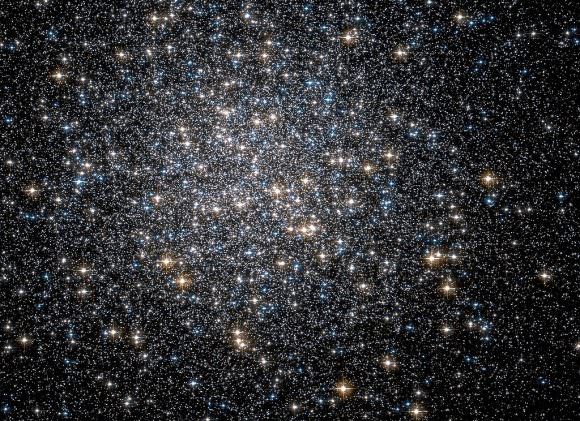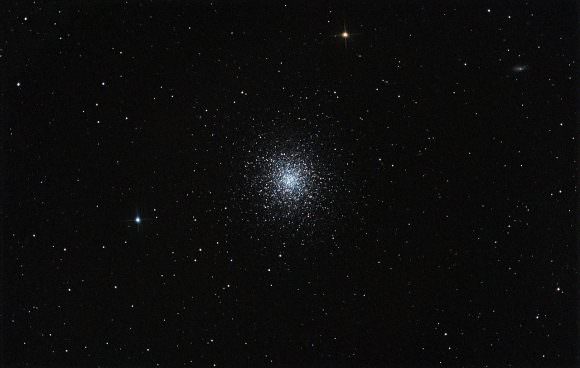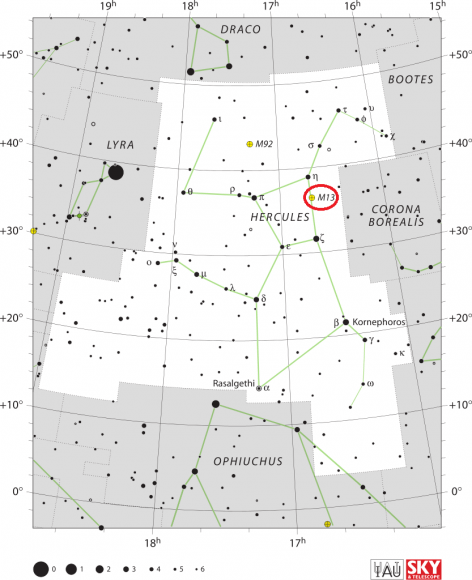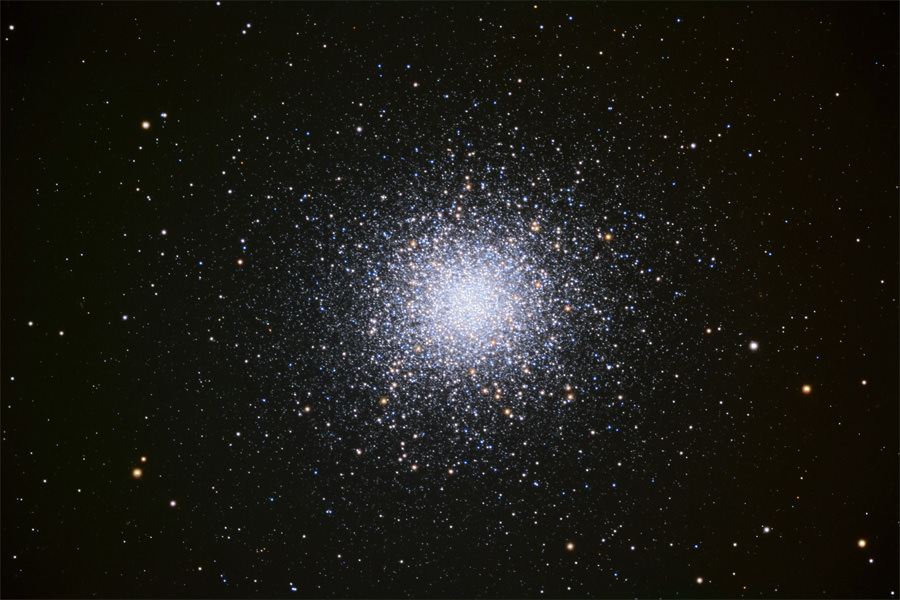Welcome back to Messier Monday! Today, in our ongoing tribute to Tammy Plotner, we take a look at the M13 globular cluster, which is often referred to as the Great Globular Cluster in Hercules. Enjoy!
In the 18th century, French astronomer Charles Messier began cataloging all the “nebulous objects” he had come to find while searching the night sky. Having originally mistook these for comets, he compiled a list these objects in the hopes of preventing future astronomers from making the same mistake. In time, the list would include 100 objects, and would come to be known as the Messier Catalog to posterity.
One of these objects is M13 (aka. NGC 6205) a globular cluster located in the Hercules constellation. Located some 25,100 light-years away from Earth, this cluster is made up of 300,000 stars and occupies a region of space that measures 145 light-years in diameter. Given its sheer size and its location, it is often referred to as the “Great Hercules Cluster”.
Description:
This 11.65 billion year old formation of stars is one of the most impressive globular clusters in the northern hemisphere. Containing over 300,000 stars packed into a 145 light year sphere, the center of this glorious object is 500 times more concentrated than its outer perimeters. And out of all of those stars there stands one stranger – Barnard 29. This spectral type B2 star is a young, blue star that M13 is believed to have collected during one of its tours around the Milky Way Galaxy.
Other interesting finds include the 15 blue straggler star candidates and 10 other possible that have been spotted by the Hubble Space Telescope. The stars in the blue horizontal branch of M13 appeared to be centrally depleted relative to other stellar types and the blue stragglers in the combined sample are centrally concentrated relative to the older red giant stars.

However, the Stromgren photometry work performed by Frank Grundah (et al.) suggests this is a normal occurrence in evolution. “We also note the existence of what appears to be two separate stellar populations on the horizontal branch of M13. Among other possibilities, it could arise as the result of differences in the extent to which deep mixing occurs in the precursor red giants.”
In their 2002 study, “An aligned stream of low-metallicity clusters in the halo of the Milky Way“, astronomers Yoon and Lee declared:
“One of the long-standing problems in modern astronomy is the curious division of Galactic globular clusters, the “Oosterhoff dichotomy,” according to the properties of their RR Lyrae stars. Here, we find that most of the lowest metallicity clusters, which are essential to an understanding of this phenomenon, display a planar alignment in the outer halo. This alignment, combined with evidence from kinematics and stellar population, indicates a captured origin from a satellite galaxy. We show that, together with the horizontal-branch evolutionary effect, the factor producing the dichotomy could be a small time gap between the cluster-formation epochs in the Milky Way and the satellite. The results oppose the traditional view that the metal-poorest clusters represent the indigenous and oldest population of the Galaxy.”
As to how old M13’s stars are, there is more than one answer. According the work of R. Glebocki (et al), stellar rotation within Messier 13 can also play a role in how the stars age. As they state in their 2000 research study, “Catalog of Projected Rotational Velocities”:
“Much theoretical and observational work about the role that rotation plays in stellar evolution has been done. Angular momentum is one of the fundamental parameters in the process of star formation as well as in early life of a star. A considerable amount of research has been done on the stellar axial rotational velocities. Clusters present unique possibility of determination of age of stars.”

History of Observation:
M13 was originally discovered by Edmond Halley in 1714. In his notes, he wrote of the cluster: “This is but a little Patch, but it shews it self to the naked Eye, when the Sky is serene and the Moon absent.”
On June 1st, 1764, Charles Messier officially catalogued the star cluster as item 13. As he described it at the time:
“In the night of June 1 to 2, 1764, I have discovered a nebula in the girdle of Hercules, of which I am sure it doesn’t contain any star; having examined it with a Newtonian telescope of four feet and a half [FL], which magnified 60 times, it is round, beautiful & brilliant, the center brighter than the borders: One perceives it with an ordinary [non-achromatic] refractor of one foot [FL], it may have a diameter of three minutes of arc: It is accompanied by two stars, the one and the other of the ninth magnitude, situated, the one above and the other below the nebula, & little distant. I have determined its position at its passage of the Meridian, and compared with the star Epsilon Herculis; its right ascension has been concluded to be 248d 18′ 48″, and its declination 36d 54′ 44″ north. It is reported in the Philosophical Transactions, no. 347, page 390, that Mr. Halley discovered by hazard that nebula in 1714: it is, he says, almost on a straight line with Zeta and Eta according to Bayer, a bit closer to the star Zeta than to Eta, & when comparing its situation between the stars, its place is rather close to Scorpius 26d 1/2 with 57 degrees Northern [ecliptic] latitude, it is nothing but a small patch; but one sees it well without a telescope when the weather is fine, and if there is no light of the moon.”
Although Sir William Herschel would soon enough resolve it into stars and again by his son and many others, no one described the history of this object more eloquently than Admiral Smyth:
“A large cluster, or rather ball of stars, on the left buttock of Hercules, between Zeta and Eta; the place of which is differentiated from Eta Herculis, from which it lies south, a little westly, and 3deg 1/2 distant. This superb object blazes up in the centre, and has numerous outliers around its attenuated disc. It was accidentally hit upon by Halley, who says, “This is but a little patch, but it shows itself to the naked eye, when the sky is serene, and the moon absent.” The same paper, in describing this as the sixth and last of the nebulae known in 1716, wisely admits, “there are undoubtedly more of these which have not yet come to our knowledge:” ere half a century passed, Messier contributed his 80 or 90 in the Catalogue of 103; and before the close of that century WH [William Herschel] alone had added to the above 6, no fewer than 2500; and his son, in re-examining these, added 520 more! In my own refractor its appearance was something like the annexed diagram; but I agree with Dr. Nichol, that no plate can give a fitting representation of this magnificent cluster. It is indeed truly glorious, and enlarges on the eye by studying gazing. “Perhaps,” adds the Doctor, “no one ever saw it for the first time through a telescope, without uttering a shout of wonder.” This brilliant cluster was discovered by Halley in 1714; and fifty years afterwards it was examined by M. Messier, with his 4-foot Newtonian, under a power of 60, and described as round, beautiful, and brilliant; but, “ferret” as he was in these matters, he adds, “Je me suis assuré qu’elle ne contient aucune étoile.” This is rather startling, since the slightest optical aid enables the eye to resolve it into an extensive and magnificent mass of stars, with the most compressed part densely compacted and wedged together under unknown laws of aggregation. In 1787, Sir William Herschel pronounced it “a most beautiful cluster of stars, exceedingly compressed in the middle, and very rich.” It has been recently viewed in the Earl of Rosse’s new and powerful telescope, when the components were more distinctly separated, and brighter, than had been anticipated; and there were singular fringed appendages to the globular figure, branching out into the surrounding space, so as to form distinct marks among the general outliers.”
And so Messier 13 has been part of our imaginations for many years. And in 1974, a message was sent from Arecibo Observatory designed to communicate the existence of human life to hypothetical extraterrestrials. Known as the “Aricebo Message”, it was expected that this communique had a better chance of finding intelligent life since the odds of it existing within this massive cluster of stars was greater than elsewhere.

Locating Messier 13:
To locate M13, all one needs to know is the “Keystone” asterism of Hercules. While this lopsided rectangle isn’t particularly bright, once you understand where to find it, you’ll be able to spot it even under relatively light-polluted skies. Both Vega (in the constellation of Lyra) and Arcturus (in Bootes) are very bright stars and the keystone is about 1/3 the distance between them.
Once you locate it, always remember that Messier 13 is on the leading western side – no matter what position Hercules may be in. By just generally aiming your binoculars in the center of the two stars on the western side, you can’t miss this big, bright globular cluster. When using a finderscope, aim slightly north of the center point and you’ll easily spot it as well. From a dark sky location, M13 can often be seen unaided as a small, fuzzy spot on the sky.
And here are the quick facts on the Great Hercules Cluster to help you get started:
Object Name: Messier 13
Alternative Designations: M13, NGC 6205, the “Great Hercules Cluster”
Object Type: Class V Globular Cluster
Constellation: Hercules
Right Ascension: 16 : 41.7 (h:m)
Declination: +36 : 28 (deg:m)
Distance: 25.1 (kly)
Visual Brightness: 5.8 (mag)
Apparent Dimension: 20.0 (arc min)
We have written many interesting articles about Messier Objects here at Universe Today. Here’s Tammy Plotner’s Introduction to the Messier Objects, , M1 – The Crab Nebula, M8 – The Lagoon Nebula, and David Dickison’s articles on the 2013 and 2014 Messier Marathons.
Be to sure to check out our complete Messier Catalog. And for more information, check out the SEDS Messier Database.

